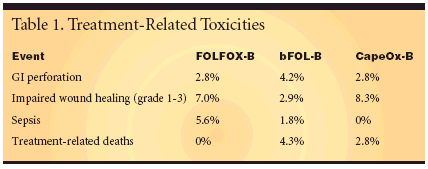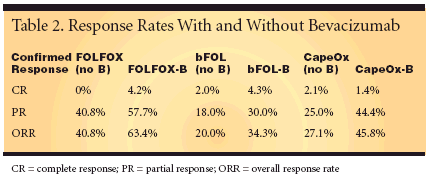Bevacizumab Increases Efficacy of Oxaliplatin- Based Chemotherapy for Metastatic CRC
NEW YORK-Adding bevacizumab(Avastin) to oxaliplatin [Eloxatin]/fluorouracil or to oxaliplatin/capecitabine (Xeloda) improves re
NEW YORK-Adding bevacizumab(Avastin) to oxaliplatin [Eloxatin]/fluorouracil or to oxaliplatin/capecitabine (Xeloda) improves responserates and is tolerable as firstlinetreatment of patients with metastaticcolorectal cancer (CRC), HowardS. Hochster, MD, of New YorkUniversity School of Medicine reported(abstract 3515).TREE-1 and TREE-2 StudiesThe TREE-1 study (n = 147) examinedresponses to first-line FOLFOX6(oxaliplatin, leucovorin, and bolus5-FU followed by 5-FU infusion);bFOL (oxaliplatin, leucovorin, bolus5-FU); and CapeOx (capecitabine, oxaliplatin).The TREE-2 study (n = 213)examined the effect of adding bevacizumabto each of these three regimens.The primary study endpoints wereoverall incidence of grade 3/4 toxici-ties during the first 12 weeks of studytherapy. Secondary endpoints wereefficacy (overall response rate), timeto tumor progression, overall survival,and time to treatment failure. Eligiblepatients had measurable, untreatedmetastatic CRC and a performancestatus of 0 or 1."The addition of bevacizumab inTREE-2 caused increased grade 3/4hypertension, impaired wound healing(5%), and bowel perforation (3%)in each arm," Dr. Hochster said."However, grade 3/4 toxicity with firstlinebevacizumab plus oxaliplatinbasedchemotherapy is acceptable andis less than reported for IFL (irinotecan[Camptosar], 5-FU, leucovorin)."Treatment-related toxicities are shownin Table 1.


Regimens ActiveAll the fluoropyrimidine regimenswere active, but Dr. Hochster said thatFOLFOX had the best balance of responseand toxicity. "Bevacizumab sig-nificantly improved response rates (P= .011) when added to oxaliplatin/fluoropyrimidine chemotherapy," hesaid. Confirmed overall response rateswere 63.4% with FOLFOX-B, 34.3%with bFOL-B, and 45.8% with CapeOx-B (Table 2).During an oral discussion, CharlesBlanke, MD, of Oregon CancerInstitute, Portland, said, "The additionof bevacizumab always increasedresponse, although the confidenceintervals overlapped. Bolus 5-FUappeared to be inferior to FOLFOXand probably to capecitabine-oxaliplatinin regard to time to treatmentfailure."
Newsletter
Stay up to date on recent advances in the multidisciplinary approach to cancer.